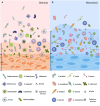Oral microbiota dysbiosis accelerates the development and onset of mucositis and oral ulcers
- PMID: 36846768
- PMCID: PMC9948764
- DOI: 10.3389/fmicb.2023.1061032
Oral microbiota dysbiosis accelerates the development and onset of mucositis and oral ulcers
Abstract
With the rapid development of metagenomic high-throughput sequencing technology, more and more oral mucosal diseases have been proven to be associated with oral microbiota shifts or dysbiosis. The commensal oral microbiota can greatly influence the colonization and resistance of pathogenic microorganisms and induce primary immunity. Once dysbiosis occurs, it can lead to damage to oral mucosal epithelial defense, thus accelerating the pathological process. As common oral mucosal diseases, oral mucositis and ulcers seriously affect patients' prognosis and quality of life. However, from the microbiota perspective, the etiologies, specific alterations of oral flora, pathogenic changes, and therapy for microbiota are still lacking in a comprehensive overview. This review makes a retrospective summary of the above problems, dialectically based on oral microecology, to provide a new perspective on oral mucosal lesions management and aims at improving patients' quality of life.
Keywords: dysbiosis; oral microbiota; oral mucositis; probiotics; recurrent aphthous stomatitis (RAS).
Copyright © 2023 Min, Yang, Hu and Huang.
Conflict of interest statement
The authors declare that the research was conducted in the absence of any commercial or financial relationships that could be construed as a potential conflict of interest.
Figures




Similar articles
-
Chemotherapy-induced oral mucositis is associated with detrimental bacterial dysbiosis.Microbiome. 2019 Apr 25;7(1):66. doi: 10.1186/s40168-019-0679-5. Microbiome. 2019. PMID: 31018870 Free PMC article.
-
Mucosal and salivary microbiota associated with recurrent aphthous stomatitis.BMC Microbiol. 2016 Apr 1;16 Suppl 1:57. doi: 10.1186/s12866-016-0673-z. BMC Microbiol. 2016. PMID: 27036492 Free PMC article.
-
Probiotics Can Cure Oral Aphthous-Like Ulcers in Inflammatory Bowel Disease Patients: A Review of the Literature and a Working Hypothesis.Int J Mol Sci. 2019 Oct 11;20(20):5026. doi: 10.3390/ijms20205026. Int J Mol Sci. 2019. PMID: 31614427 Free PMC article. Review.
-
Mucosal microbiome in patients with recurrent aphthous stomatitis.J Dent Res. 2015 Mar;94(3 Suppl):87S-94S. doi: 10.1177/0022034514565458. Epub 2014 Dec 24. J Dent Res. 2015. PMID: 25540188 Free PMC article.
-
The role of oral microbiota in the development of oral mucositis in pediatric oncology patients treated with antineoplastic drugs: a systematic review.BMC Oral Health. 2024 Feb 5;24(1):183. doi: 10.1186/s12903-024-03938-y. BMC Oral Health. 2024. PMID: 38317151 Free PMC article.
Cited by
-
Development of a Novel Histatin-5 Mucoadhesive Gel for the Treatment of Oral Mucositis: In Vitro Characterization and In Vivo Evaluation.AAPS PharmSciTech. 2023 Aug 28;24(7):177. doi: 10.1208/s12249-023-02632-6. AAPS PharmSciTech. 2023. PMID: 37639072
-
Targeted prevention of radiation-induced oral mucositis by glutathione-modified liposome coated K12 probiotics and clinical study.Mater Today Bio. 2025 Jul 29;34:102142. doi: 10.1016/j.mtbio.2025.102142. eCollection 2025 Oct. Mater Today Bio. 2025. PMID: 40791797 Free PMC article.
-
Magnesium metal-organic framework microneedles loaded with curcumin for accelerating oral ulcer healing.J Nanobiotechnology. 2024 Sep 30;22(1):594. doi: 10.1186/s12951-024-02873-y. J Nanobiotechnology. 2024. PMID: 39350179 Free PMC article.
-
Microbiota-Host Interactions: Exploring Their Dynamics and Contributions to Human Diseases.Microbiologyopen. 2025 Aug;14(4):e70043. doi: 10.1002/mbo3.70043. Microbiologyopen. 2025. PMID: 40770906 Free PMC article. Review.
-
Carboxymethyl Chitosan/Sodium Alginate/Chitosan Quaternary Ammonium Salt Composite Hydrogel Supported 3J for the Treatment of Oral Ulcer.Gels. 2023 Aug 16;9(8):659. doi: 10.3390/gels9080659. Gels. 2023. PMID: 37623114 Free PMC article.
References
-
- Abduljabbar T., Al-Askar M., Baig M. K., AlSowygh Z. H., Kellesarian S. V., Vohra F. (2017). Efficacy of photodynamic therapy in the inactivation of oral fungal colonization among cigarette smokers and non-smokers with denture stomatitis. Photodiagnosis Photodyn. Ther. 18 50–53. 10.1016/j.pdpdt.2017.01.182 - DOI - PubMed
-
- Adami G. R., Ang M., Kim E. (2021). The oral microbiome: Methods and protocols. New York, NY: Springer. 10.1007/978-1-0716-1518-8 - DOI
Publication types
LinkOut - more resources
Full Text Sources
Research Materials

